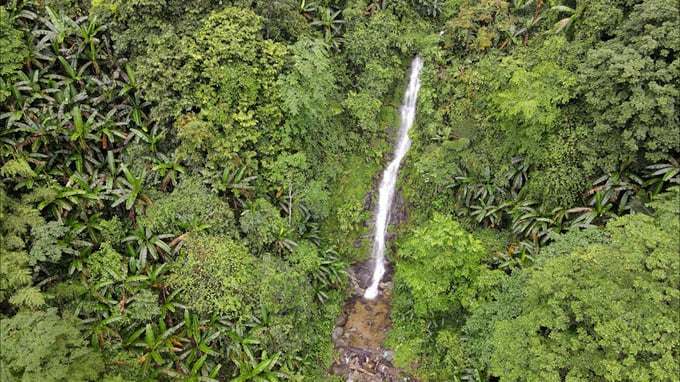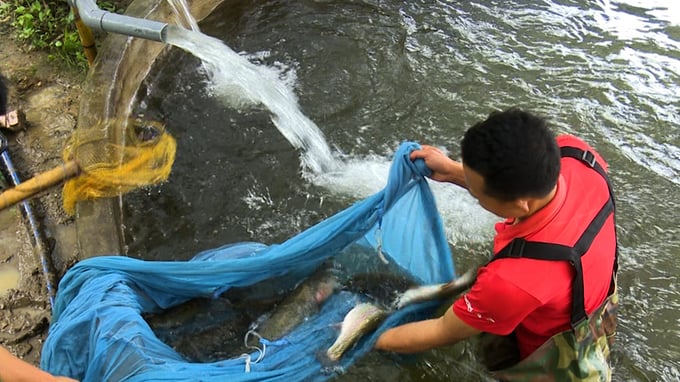June 16, 2025 | 08:22 GMT +7
June 16, 2025 | 08:22 GMT +7
Hotline: 0913.378.918
June 16, 2025 | 08:22 GMT +7
Hotline: 0913.378.918

The cool water source at the top of Pu Lau Mountain (Yen Duong Commune) provides ideal conditions for cold-water fish farming. Photo: Ngoc Tu.
Pu Lau is the highest peak of the Phja Booc mountain range in Yen Duong Commune (Ba Be District). From the summit, a small stream meanders down toward the Phieng Phang village at the foot of the mountain.
For many years, the people of Phieng Phang have utilized the cool waters of the stream for cold-water fish farming. Initially, only one household set up a pond to farm sturgeon. After seeing the success of this venture, the practice of farming sturgeon and salmon gradually expanded, and the model gained popularity throughout the village.
Today, Phieng Phang village has about 30 fish ponds. Some households manage just a few ponds, while others operate as many as ten. The largest operation is the Pu Lau Sturgeon and Salmon Cooperative, which combines fish farming with eco-tourism experiences at the top of Pu Lau Mountain. On average, the cooperative sells between 20 to 30 tons of fish annually. The price for sturgeon ranges from 12 to 14 USD/kg, while salmon is sold at approximately 17 to 19 USD/kg.
Mrs. Trieu Thi An, a resident of Phieng Phang village (Yen Duong Commune), shared that the model of farming sturgeon and salmon is very well-suited to the natural conditions of the area. Thanks to the clean, cool water from the local streams, the fish thrive and develop rapidly. In recent years, Phieng Phang has also developed community-based tourism, which has made the distribution of these fish even easier. The sturgeon and salmon from this village have gained a reputation and are well-known to many people. Not only has this fish farming model led to a steady sale of fish, but it has also provided an additional experience for tourists who come to visit Phieng Phang. This combination of fish farming and eco-tourism has contributed to the diversification of the village’s tourism offerings.

Many successful cold-water fish farming models have been developed in Phieng Phang village (Yen Duong Commune). Photo: Ngoc Tu.
Ban Chan, located in Dong Phuc Commune (Ba Be District), is blessed with a pristine stream that flows through the area, providing cool, refreshing water in the summer and warmer water in the winter.
Taking advantage of this unique water source, Mr. Hoang Van Tam decided to start his own fish farming venture by digging ponds. In 2012, when he was just beginning, he stocked his ponds with easy-to-care-for fish species such as carp, tilapia, catla, and silver carp. In his very first season, he earned over 4.000 USD in revenue. After deducting expenses, he made a profit of several thousand dollars, which he reinvested into expanding his fish farming operations.
Mr. Tam explained that he started with a few small ponds at first, but as his business grew and he was able to reinvest his profits, he expanded by digging more ponds and increasing his farming area. Today, his fish farming operation spans around 1ha of water surface, with his largest pond covering an area of 3.500 square meters.
"Because the water here is clean and cool, it allows for a variety of fish to be farmed. In addition to traditional species like black carp and carp, I can also raise other types of fish like catfish or sea bass. If I can build proper tanks, I could even farm sturgeon", Mr. Tam said.
Talking about his experience with fish farming, Mr. Tam emphasized that the most important factors for success are mastering the right techniques, ensuring the pond has a constant supply of clean water, providing an appropriate amount of feed, and taking advantage of natural food sources such as grass. He also mentioned that growing elephant grass alongside fish farming has proven to be beneficial. At present, Mr. Tam's fish farming model generates several thousands of dollars in revenue each year, creating seasonal job opportunities for 5 to 7 local workers.
Mr. To Phong Nhuan, Chairman of Dong Phuc Commune (Ba Be District), expressed that Mr. Tam's fish farming initiative has had a significant economic impact, helping to create jobs and improve the livelihood of local residents. He further explained that the commune is actively encouraging both individuals and cooperatives to invest in fish farming, particularly in high-value species.

Farming specialty fish does not require a large area, yet it brings high economic benefits. Photo: Ngoc Tu.
Ba Be District has developed a strategic plan for aquaculture zones, focusing on guiding local residents through technical processes to improve the quality of their products. The district is actively encouraging the establishment of strong production-to-consumption value chains, with a particular emphasis on combining aquaculture with community-based tourism in certain villages and hamlets that have great potential for such activities.
In recent years, several aquaculture cooperatives in Ba Be District have implemented integrated models that not only involve fish farming but also the processing of fish into local dishes, which are then served to tourists who come for experiences and leisure stays.
In recent years, aquaculture has become one of the strengths of Ba Be District, with over 127ha of water used for fish farming. This includes approximately 40 ponds for farming sturgeon and salmon, 2.600 cubic meters of cage fish farming, and the remainder consisting of ponds and lakes. The majority of the cage fish farming area is concentrated along the Nang river, which flows through the communes of Khang Ninh and Thuong Gio, while sturgeon and salmon farming is most prominent in the communes of My Phuong and Yen Duong.
Translated by Phuong Linh
/2025/06/12/3721-2-202745_83.jpg)
(VAN) TH made an impression at Seoul Food 2025 with its line of natural beverages, paving the way for Vietnamese food products to enter the South Korean market.

(VAN) Soc Trang's success in rice exports stems from a strategy of developing fragrant and specialty rice cultivation areas and standardizing production toward low-emission practices.
/2025/06/11/1311-5-120811_839.jpg)
(VAN) The pig farming industry is facing the challenge of comprehensive restructuring to meet requirements for quality, safety, traceability, and market expansion both domestically and for export.

(VAN) Vietnam considers participating in ALGROALBA in order to expand agricultural production, coordinate the assessment and effective exploitation potential land.
/2025/06/05/5314-1-184727_407.jpg)
(VAN) From seemingly worthless fish scales and skin, enzymes and lactic ferments can transform by-products into peptides, opening a sustainable, effective business direction and elevating Vietnamese seafood.

(VAN) TTC AgriS and IFC signed a strategic partnership to develop a sustainable agricultural value chain, aiming to achieve the Net Zero target by 2035.

(VAN) Seafood by-products are opening a new path, combining green growth and technological innovation to enhance the industry's value.